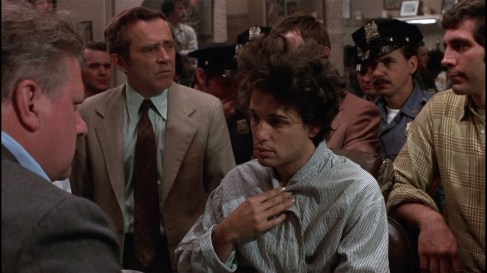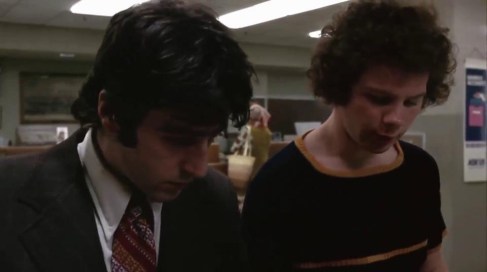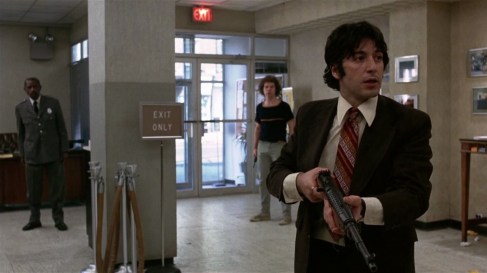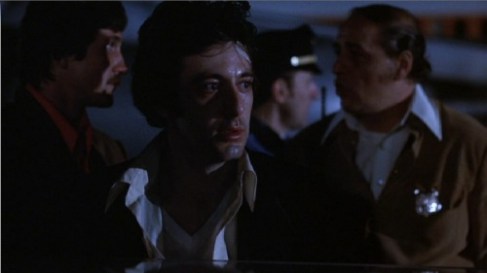Today’s cinema adventure: Serpico, the 1973 classic by director Sidney Lumet, based on the true story of the first New York police officer to speak up about the widespread graft and corruption in the city’s police force, featuring Al Pacino in an iconic early performance that cemented his status as one of Hollywood’s hottest stars and offering one of the finest examples of the kind of gritty, authentic filmmaking that made the seventies one of the richest and most influential decades in the history of cinema. Shot entirely on location in the streets and interiors of New York City, it was made on a budget of a million dollars- small even for the time- and made over 30 times that amount at the box office, riding on a wave of anti-establishment sentiment that had begun in the late sixties; its financial success helped pave the way for a sort of mini-genre that exposed injustice and corruption in government while exploring the difficulty of maintaining individual honor and integrity in such a dishonest system- a theme found in many of the period’s greatest films, reflecting the zeitgeist of an era marked by disillusionment in the powers that be and a growing mistrust of once-respected institutions of authority.
Adapted from Peter Maas’ bestselling book, the film follows the true story of policeman Frank Serpico beginning with his graduation from the New York police academy and his subsequent rapid rise from beat cop to plainclothes detective; a dedicated and exceptional officer, he excels at his job, using his spirit of innovation and his street-savvy sensibility to become the best cop he can be. Along the way, however, he repeatedly encounters colleagues who resort to unethical behavior- physical abuse of suspects, accepting handouts and bribes, and, most pervasively, extorting money in the form of shakedowns and payoffs from criminals in exchange for looking the other way. It’s a tradition that seems to be as old as the police force itself, and one in which everyone is expected to participate; those who refuse are viewed with suspicion, intimidated, scorned, and threatened by other officers. Though at first Serpico is able to remain aloof to the widespread corruption, the pressure from his colleagues eventually becomes unbearable; he tries to take action through official channels inside the police department, only to find that the entire chain of command- all the way to the top- seems bent more on ignoring and covering up the problem. When he finally joins forces with a lawyer friend and takes his story to the Mayor’s office, he is again rebuffed. When his personal life also begins to crumble due to the emotional strain of his professional situation, he finally decides to go public, telling his story to the press and forcing the department to begin a widespread internal investigation. It is Serpico’s testimony that will be the key to exposing the extensive wrongdoing on the force; perceived as a traitor to his fellow policemen, he is soon placed deliberately in danger while on duty, set up by his partners during a drug bust; shot in the face and abandoned at the scene, he nevertheless survives to bear witness at the hearings conducted by the Knapp Commission, a government agency set up to investigate largely because of his determination to make his story heard.
Though the screenplay for Serpico does take a few liberties with the true events, it is for the most part a faithful depiction of the real story. Maas’ book, written with the participation of the real Frank Serpico, was adapted faithfully for the screen by Waldo Salt, with later modifications by Norman Wexler, who restructured the narrative when director Lumet decided it was too long. In order to pack the decade-long saga into a manageable running time, the story is told in a sort of collage, constructed of mostly short scenes which document the progression of events over time; most of the faces change as Serpico is variously transferred throughout the department and makes changes in his personal life, but the thread of continuity is maintained by the main character’s presence at the center throughout and the unchanging circumstances of his dilemma- though the names and places may be different, the underlying situation is always there, showing not only the widespread nature of the problem but suggesting, by extension, that such corruption is a universal issue. It’s an approach which also helps to reduce the sense that we are seeing a “movie” with actors (though many of them are recognizable faces), lending the piece instead a feeling of genuine, fly-on-the-wall credibility. This kind of pseudo-documentary authenticity was no doubt enhanced by Serpico’s direct involvement; he was initially present on the set during shooting, until Lumet and producer Martin Bregman deemed him too distracting (or, perhaps, too intimidating) for the cast, and he was Pacino’s guest for several weeks at a rented house in Montauk, where the actor spent time with him in order to gain insight in preparation for the role.
The slice-of-life perspective Serpico uses to take us through this true story of heroism is ultimately made possible by its director. Sidney Lumet was a filmmaker with a long and varied career, starting as a child actor on Broadway (indeed, the memorable party scene early in the film was shot in the apartment of Sidney Kingsley, the playwright who hired the 11-year-old Lumet to appear in the original production of his classic Dead End), whose studied, realistic approach and emphasis on the psychology of his characters had developed through years of work in the theatre and the early days of live television drama, and had made him the kind of “actor’s director” perfect for helming the strong, character-driven films that dominated the cinematic heyday of the mid-seventies. Marked by a refusal to sentimentalize and an observational sensibility that allows both an empirical detachment and an intensely emotional connectivity, his style reached its peak during this era when polished Hollywood glamour was supplanted by a stripped-down, cinéma vérité honesty in popular filmmaking, and nowhere is it more clearly on display than in Serpico. He wasn’t the first choice for the project, however; originally slated to direct was John G. Avildsen, but creative differences with Bregman led to his eleventh-hour replacement- a fortuitous twist of artistic fate, for it’s nearly impossible to imagine the film through the lens of another director. Lumet’s instincts are a perfect match to Serpico’s story, and his love for the craft of filmmaking- and for the city of New York, in all its contrasting splendor and squalor, photographed with equal reverence by Arthur G. Ornitz- is as evident as his technical skill here, helping to capture a visceral, on-the-scene portrait not just of the city, but of its people, and transporting us so completely into the place and time that we feel we know it as well as if we were there ourselves. It’s a more genuine environment than most of the plastic-and-glass urban settings we see in modern police dramas, and one that reflects the economic reality of urban bureaucracy; it also provides a tangible sense of the rough-edged, oppressive conditions which may contribute, in some way, to the temptation for many to abuse their positions for personal gain. Lumet’s most powerful and effective tool though, is the respect he gives his actors, allowing them to command every scene and placing primary emphasis, always, on their characterizations. There are no flashy feats of camera artistry here; Lumet uses his lens unobtrusively, in full service of his cast, knowing that the story comes to life through them, and not through cinematic trickery.
Specifically, of course, it comes to life through the actor at its center. Al Pacino, already proven as an intense and charismatic performer through his star-making role in The Godfather, solidified his status as one of “New Hollywood’s” hottest talents with his scorching portrayal of the title role; he gives us a man of intelligence, humor, compassion and honor, without being afraid to show us his flaws with equal honesty. His Serpico is a hero whose fight for moral integrity also becomes a fight against himself, as the escalating frustration and pressure bring out his anger, depression, pettiness and self-doubt, and Pacino lets us have it all in an unvarnished and compelling tour-de-force that deservedly earned him an array of award nominations and wins. It’s all the more remarkable in light of the fact that the film was shot in reverse sequence, in order to accommodate the changes in Serpico’s appearance. Since his facial hair was required to become progressively more pronounced throughout the story, Pacino grew out his hair and beard before shooting began, and then gradually trimmed it back throughout the course of production; it is routine for a movie to be shot out of sequence, but even so, the clarity of Serpico’s emotional throughline is astonishing, considering it was achieved, essentially, backwards. Though Pacino carries the vast majority of the film himself, he is surrounded by a fine gallery of supporting players, most significantly Tony Roberts, lending his dry and urbane charm to the role of the department lawyer who becomes Serpico’s friend and ally, and including such stalwart and familiar (or soon-to-be-familiar) actors as John Randolph, Jack Kehoe, Lewis J. Stadlen, F. Murray Abraham, M. Emmet Walsh, Judd Hirsch, and Tony Lo Bianco. The entire cast becomes fully immersed in the film’s reality, without a single “actorish” performance among them- though Barbara Eda-Young and Cornelia Sharpe, as the two significant women in Serpico’s life, seem stiff and more than a little out of their depth as they attempt to share the screen with their formidable co-star.
Serpico, when it was released four decades ago, was as topical and current a movie as you could get, offering for consideration a subject and story fresh from the nightly newscasts and the national papers. Today, of course, it seems somewhat dated, to the casual viewer; the world it shows us, though utterly authentic in its day, now feels almost quaint, a nostalgic reminder of a time before cell phones and computer networks became standard operating equipment and video surveillance equipment captured virtually every move an officer could make on duty. The environment and the situations strike us as a pastiche of familiar cop show clichés threaded with liberal naïveté; indeed, the corruption of Serpico’s fellow officers is amateur stuff compared with the staggering cases of corporate and governmental chicanery that have come to light, over and over, in the years that have gone by since. Even so, Serpico remains a powerful cinematic document of its time and place, infused with a sense of moral outrage and antiestablishment fervor that is still quite capable of moving us. Much of this has to do with Pacino’s electrifying, impassioned performance, of course; but it’s the film’s focus, built into its screenplay and shrewdly maintained by its director, that ultimately allows it to transcend its era and stand as more than a well-crafted period piece. Lumet doesn’t care about the details of the corruption against which his hero fights- the nuts and bolts of the investigation are passed over in his movie, with only enough specific circumstance to set the stage for the real drama that concerns him. That drama is not about the external events of Serpico’s life, but about the effect those events have on his inner self- the struggle, the emotional stress, the conflicting guilt that comes of being forced to betray one deeply held ideal in order to uphold another. Serpico emerges, most of all, as a meditation on heroism- not the guts-and-glory kind that is usually the focus of police dramas, but the kind required to withstand the inner turmoil that makes standing up for your principles something that is easier said than done. It offers us a portrait of a real life figure willing to sacrifice the thing which mattered most to him- being a cop- in order to be right with his own conscience, and it does so without the kind of cloying sentimentality that so often makes such movies feel more insincere than inspirational. The real-life Frank Serpico told Al Pacino, when the actor asked him why he decided to come forward about the corruption inside the NYPD, that he had done it because, “if I didn’t, who would I be when I listened to a piece of music?” It’s a rare man who can recognize the importance of such a distinction, and a rare movie that can help us recognize it, too. Serpico is such a movie, and that in itself- even more than the towering performance of its star- is what makes it a classic.
http://www.imdb.com/title/tt0070666/?ref_=sr_1






















































